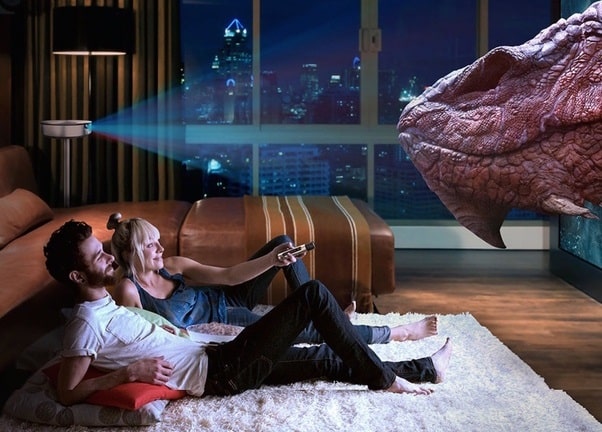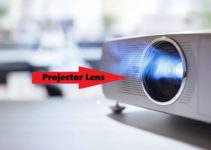- What is a 3D Projector?
- Types of 3D Projectors
- Difference between passive and active 3D Projectors
- Can I watch 3D movies on a projector?
- How to make 3D viewing experience more comfortable
- How to choose the most suitable 3D glasses
What is a 3D Projector?
3D projection is an awesome way to bring people closer than ever before. Now, thanks to 3D projections we can help your audience feel as if they are standing in the middle of a field or exploring inside Mount Everest all from their seats!
The feeling of depth lets you explore places that would otherwise be geographically impossible for most folks and experience everything firsthand.
To create this 3D effect, two nearly identical images are projected onto the screen simultaneously. These glasses allow you to see both of these images with each eye and make for an interesting way to watch movies in a whole new light!
Types of 3D Projectors
Using a variety of formats, 3D videos are transmitted and projected by both 2D projectors as well as 3D projectors. With these two types of technologies in the market today, it is important to find out which one would be best for your needs based on whether you want an immersive or a non-immersive experience.
Full 3D projectors
Full 3D projectors use three different types of stereo images to create a full, immersive image. Full 1080p projection is perfect for high definition movies and games with stunning detail in light or dark settings. HDMI 1.4 compatibility makes it easy to connect your computer or laptop while Blu-ray™ compatibility allows you access to the latest Hollywood blockbusters on demand!
While some people are looking into cheaper options like Epson Home Cinema 3700 at $1400, most others find that spending just a little more money gets them an upgraded experience worth every penny!
3D Ready Projectors
3D-ready projectors are designed to handle only the Frame Sequential data transmission format. This design helps reduce production cost as frame sequential transmission is one of the simplest forms of 3D. Unfortunately people often purchase these projects thinking they will work with their TV or monitor and are then disappointed because they can’t view in three dimensions on a standard 2d screen.
This method of transmission is bandwidth extensive because the projector does not need to decode the data stream. It can display it directly at 120 frames per second which means that for every 1 frame sent, the other eye gets another one – so there are 2 pictures being displayed in order to provide full resolution and a stereo experience.
A frame sequential signal is sent as a full resolution picture at 120 frames per second. These frames alternate sequentially, sending a frame for the left eye, then another for 3D movie glasses.
Another three seconds later without needing to decode or process any data in between. The only requirement of this method of transmission is that it can accept 120Hz signals and has enough bandwidth so each eye gets its own complete image every 4th millisecond with no lag time whatsoever – which technically means you’re getting 240 images from one transmitter instead!
Difference between passive and active 3D Projectors

There is no clear winner between active and passive projection technology as they both have their pros and cons.
Active 3D Projection Technology
An active 3D projector uses a battery and scanning system to divide an image into alternate views for each eye. The active 3D glasses then synchronize with the active 3D projector by emitting synchronization signals (typically IR). Passive systems, on the other hand, use polarizing filters in front of the TV screen that block light from one eye at a time while using polarized lenses inside the viewer to present different images; this is called “passive” because it does not require any electronic components or emitters.
Passive 3D Projection Technology
Passive 3D Projectors are also known as Autostereoscopic Displays – they create depth without requiring head tracking sensors like active projection technology does. They typically work better when there isn’t too much ambient light in a room.
Active 3D Projectors have a higher refresh rate and active glasses can be lighter, but passive systems will work in low light conditions better. Passive models are also less expensive to buy or rent than active ones which makes them more accessible for consumers.
Can I watch 3D movies on a projector?
There are many projectors to choose from and finding 3D-ready models is as easy as checking the product’s specs. The trickier part of this question might be deciding whether you really want a projector, or a TV instead!
The simple answer to this question is yes – but there are some tricky parts that we’ll get into later on in our article. If flat screens started getting old for you because they only had 2 dimensions then try out 3 dimensional projections with your home theater system today!
How do I make my 3D viewing experience the most comfortable
3D has become the latest and greatest in cinema, but how do you make sure that your 3D viewing experience is as pleasurable as possible? That’s what we’re going to cover today.
3-dimensional movies are a novelty for most people these days – they’ve been out since about 2004. They weren’t around prior to this time because of some technical difficulties with them having an image depth perception on screen when viewed from different angles or distances away from it (think back before 2007). But now, things have changed; technology has evolved. Nowadays there are new projectors available which can offer both 2D images AND 3 dimensional ones! We’ll be discussing those later down the line though…
The human brain is able to perceive depth because the left and right eye each see a different perspective of an object, which our brains then synthesize into a sense of how far away that object actually is. This phenomenon, called stereoscopic vision, forms the foundation for all 3D video as it relies on presenting slight variations between what both eyes can view in order to simulate the perception we have when viewing objects with two-dimensional sight. The quality or effectiveness of any given 3D video depends entirely upon how well its creators are able to replicate this natural phenomena by providing slightly differing images on opposite sides so they may be viewed simultaneously without distortion; only those who effectively recreate this sensation will produce high-quality videos worthy enough for virtual reality applications.
The 3D videos we watch today are immersive and leave us feeling like our favorite characters have come to life. This experience is primarily due to the glasses wearing audience members must do in order to view these films, which allow for a side-by-side image that reflects each eye’s perception of depth in space as well as high quality visuals on screen. In order for this amazing magic trick be performed by filmmakers who know what they’re doing, there needs be plenty of considerations made before shooting begins such as format (2D vs 3D), use or type of glasses worn while watching film with an electromagnetic shutter system only one lens at time is active while viewing images from projector positioned further than 500 inches away and overall quality projections.
How do you choose the most suitable 3D glasses
Your 3D glasses can greatly affect the quality of your viewing experience. There are 2 major types on the market today: passive and active, with each type having its strengths and weaknesses in terms of price, comfortability, battery life etc.
Passive 3D Glasses
Passive 3D glasses are a blessing for the budget-conscious film watcher. In comparison to active 3D glasses, an extra cost of $1 per audience member is associated with passive ones! However, while there’s no battery powering these spectacles which make them cheaper than their counterparts, viewing quality can be diminished as polarized lenses filter out half of the projected image from each eye.
Passive 3D glasses will cost you an extra $200 to get a polarizing module that is needed for the passive system. So if your budget doesn’t allow it, then this may not be what you’re looking for. Passive 3-d systems are available but they don’t have as many features and do require some additional equipment like batteries or power cords which can make them difficult when portability isn’t important because of their reliance on other external devices such as cables or chargers since most people prefer these days in order to save battery life.
Passive three dimensional (3D) glasses rely on a different optical principle than frame sequential multi projector programmed stereoscopic projection technology used by projectors nowadays making those more expensive and requiring purchasing
Active 3D Glasses
Active 3D glasses are what make the movie theater experience so immersive. They work by projecting frames to different lenses at a high frequency – such that one lens is always opaque, and the other constantly transparent for each frame of an animation or film.
Active 3D glasses use rapidly-changing lenses with which they can project 2 separate images onto your eyes; depending on whether you’re watching something intended for your left eye (your right lens will be clear) or vice versa (left lens will turn dark).
Passive 3D glasses are cheaper than active ones, but they don’t work with all projectors. Active 3D is more expensive and works on a wider variety of devices including TVs.
How do 3D Projectors Work
The 3D film method works by shooting slightly different left and right angles in a scene, with camera lenses set roughly apart at the distance between your eyes, then feeding each different angle into the respective left and right eyes of the viewer. The Human Visual System is a highly complex set of processes when it comes to depth perception. One eye focuses on one image and the other eye on an offset version of the first. The brain “sees” three virtual images instead of two (the middle virtual image is a combination of the two real incoming signals.

The brain does complex binocular processing, combined with looking for depth cues, based on previous experiences, like the size of objects, the amount of detail that can be seen, relative movement etc. and makes a constructed scene in an internal 3D space model that all people with normal sight develop.
There are many ways to make 3D films – moving 3D imaging has been around for 105 years. The question “how do 3d movie projectors work” needs a bit of history to understand.
There were two main waves in 3D movies. One in the 1950s, used chemically developed optical 35mm film and (sometimes) those old colored anaglyph glasses viewing a single film, or polarised glasses being fed two different images from two optical correspondingly polarised film projectors. If you have wondered how do polarized 3D projectors work exactly, it’s by shooting the two different angles, then filtering the two resulting images by two different polarizing filters. The filters can be different angles, or opposing spirals allowing only the left image to reach the left eye and vice versa.
1950’s 3D ‘Creature Features’ like ‘Creature from the Black Lagoon’ made good money. However, it was expensive and hit and miss, both to shoot and to watch – you didn’t know what’s on an optical film until it came back from the lab.It died but lots of content was generated. The old joke was “Q: How do 3d cinema projectors work? A: Badly”.
Jump forward to 17 years ago and a second wave, this time using more reliable digital technology.
Digital stereo 3D typically uses two digital cameras linked together on a special rig to photograph the scene. The center point of each of the camera lenses is about the normal distance between the eyes of an adult (the interocular distance). To change the amount of stereo effect, this is increased or decreased. Unlike the 1950s, going digital meant everything could be checked and fixed during production, post-production, or mastering. This meant the audience headaches commonly caused by earlier methods were drastically reduced and production costs were slashed as re-shooting or other issues could be avoided.
It was still a much more expensive process than a normal film and there was a big push to use stereoscopic remastering – a normal film was shot then ‘converted’ to appear to be stereo.
A huge amount of 3D content was created again, including big money-making titles like “Avatar”, “Hannah Montana/Miley Cyrus” and ‘Polar Express” or even 3D miniatures. Cinemas geared up primarily with the polarised digital projection system developed by RealD 3D. In the RealD system, passive glasses are used with opposite polarisation in each eye and twin signals are projected, one for each eye.
Other cinemas used XpanD 3D, active battery-powered shutter glasses. In this system, the glasses switch on and off alternately on each lens with a synchronized alternative frame sent by the daylight projector.
A third dichroic filter based system was promoted by Dolby, where slightly different bands of color frequencies were sent to each eye.
For many reasons 3D cinema audience numbers slowly declined – though they did not wholly go away. Again it was about cost – the technology all worked but it is always the case to remember that the term show business includes the word ‘business’.
When will the next 3D wave come – well, stay tuned for hologram.






